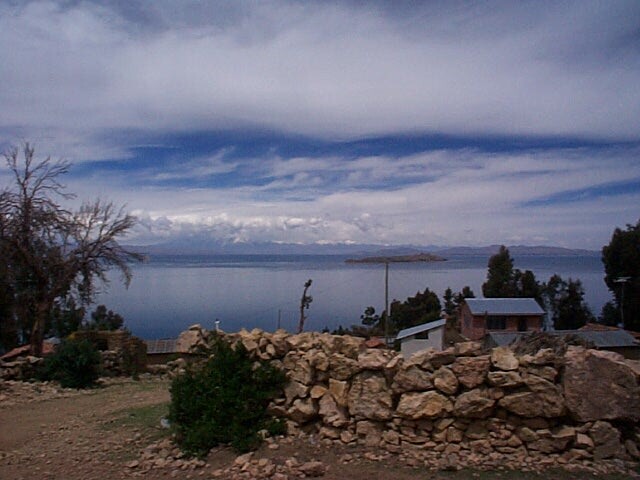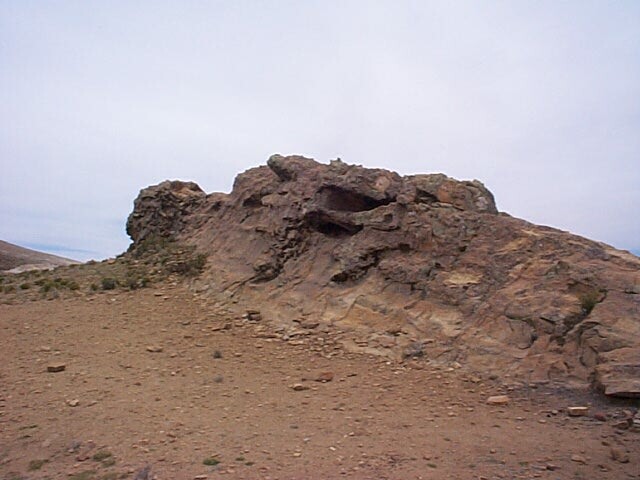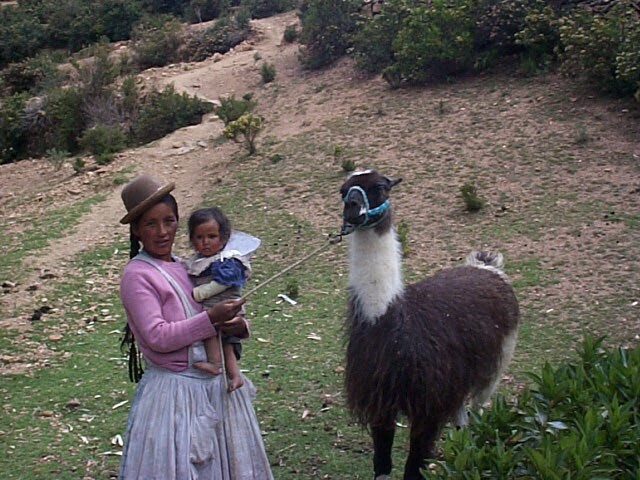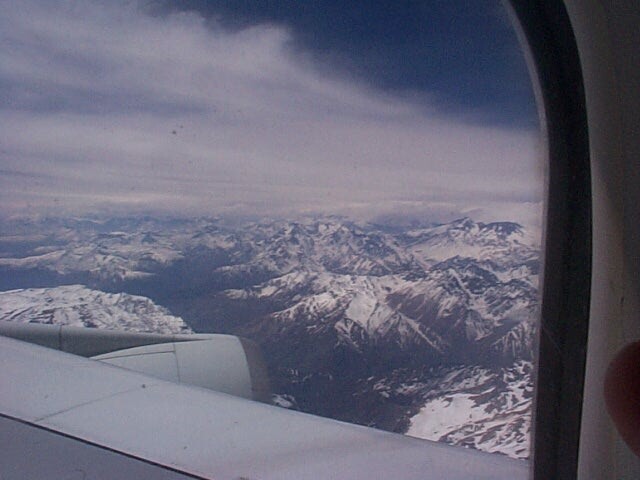
- November 1, 1999
- Buenos Aires, Argentina
Hello again from Buenos Aires. Welcome to the second half of my great adventure. If you missed the first half and want to read about how I managed to get to La Paz, Bolivia, click here.
Well, I left off on Monday the twenty-fifth in the town of La Paz on my way to Copacabana. The bus between these two small towns is pretty unassuming, but plenty comfortable for the four hour ride. Copacabana is Bolivia's principal tourist town on Lake Titicaca, a huge inland sea trapped in the Andes Mountains. In total the lake is about 110 miles long and about 35 miles wide, so it's not to shabby when it comes to size. One can not see across it. Below is a nice shot of the lake with the Cordillera Real mountains in the background and a typical Bolivian house with what they would call a "fence." Obviously rocks are easier to come by than wood or wire.

To get to Copacabana one has to cross a small channel where the large end of the lake and a smaller branch connect. Our bus went on one barge and us on another. I mention this only because of the extraordinary work or our boat driver, a young man of about seven or eight years in age. The real boat driver was essentially worthless. He didn't steer. He didn't start the engine. He couldn't even fix the engine when it broke halfway across. This little kid did it all, a pattern which I noticed repeated across Bolivia. Without children it was questionable whether the country would run at all.

Copacabana is a pleasant little place, about the size of Schoolcraft perhaps. It's got enough tourists to just about be the third seat of the United Nations, but given that they're mostly Australians, New Zealanders, British, or otherwise European, I can't see that happening anytime soon. I did run into a guy from New Zealand who was traveling with a Dane, and the three of us found a hotel together and then ran into two American girls and spent the evening on the beach watching the sunset and looking at the Southern Hemisphere stars.
On Tuesday I rose bright and early to head down to the beach and catch a boat to Isla del Sol, the island that is the location of the Inca creation legend. The morning was clouded over so I didn't think to take any kind of sun protection (I normally don't anyway) and I would regret it later. Once on the island we hiked out to the ruins of the Inca temple where the priests once lived. We also saw the rock on which they would sacrifice a virgin every year (the virgins were kept on Isla de la Luna nearby). The "climax" of the excursion was getting to see the "Sacred Rock" from which the first to Incas were born.
 As the story goes, a
man and a woman burst forth from the Sacred Rock and then produced the Sun and the Moon
from their union. From then on came the remainder of the Inca story. The rock was
certainly unassuming, only about ten feet tall, but culturally it was like being able to
visit the Garden of Eden for about six bucks, so I count it as one of my cool experiences
in South America. On the left is the all-important rock. In about 1981 National
Geographic did a good article on some of the archeology being done on Isla del Sol which
some of you might want to check out.
As the story goes, a
man and a woman burst forth from the Sacred Rock and then produced the Sun and the Moon
from their union. From then on came the remainder of the Inca story. The rock was
certainly unassuming, only about ten feet tall, but culturally it was like being able to
visit the Garden of Eden for about six bucks, so I count it as one of my cool experiences
in South America. On the left is the all-important rock. In about 1981 National
Geographic did a good article on some of the archeology being done on Isla del Sol which
some of you might want to check out.
From the site of the ruins at the northern end of the island we took off hiking along the high spine of the island to the southern end where the boat would return to pick us up. Isla del Sol is totally void of vegetation, and by mid day the sun was out in full force. I got rather toasted that afternoon. The hike was beautiful, however, and I had a nice conversation with a longshoreman from Vancouver on the way.
We arrived at the southern end in plenty of time and descended the Fuente del Inca, a set of stairs that run along a natural spring. Both the spring and the stairs predate the Incas. As we were on our way down we greeted the various women working the terraced gardens made available by the fact that the spring provides water and that the Incas build the terraces some five hundred years ago. One of these women got up from here work and asked if I would like to take a picture of here llama and naturally I said sure, being that getting pictures of people or their animals is tricky business because it's difficult to do so in a non offensive way. The shot cost me about fifty cents, but it was worth it. Being inquisitive, I asked here then what she used the llama for, thinking that perhaps they drank llama milk, or she make clothing out of llama wool. Her response, however, was less ethnically dramatic. She kept the llama only so that she could have tourists pay her to take pictures of it. I'm sure she made a killing with that llama. In any case, below is that photo.

Yes, many Bolivian women still dress in this traditional outfit. I didn't see any men in what one would quailify as "traditional," but more than half of the women were. It would be interesting to return in about ten years and see if the culture trends take them more Western or if the tradition can survive. It would be a shame if it did not.
On Wednesday I traveled to the Bolivian-Peruvian border about seven miles from Copacabana. I had the Bolivians stamp my passport in Kisani, and then hiked over that invisible but all-important line to have the Peruvians stamp it. From Kisani I took a bus around the edge of the lake to where the road crossed again into Bolivia in the town of Desaguadero. In total I think I was in Peru for about two hours.
I crossed into Bolivia and looked for bus to La Paz. Finding one was a matter of waiting, which would have been fine except that Desaguadero is truly a miserable place. Unless one really wants to have a Peruvian stamped passport, I do not recommend it.
The ride from Desaguadero was long and crowded. I arrived in La Paz around ten at night, and the only buses going south left in the morning. While in the bus station I ran into a group of Bolivians who had just finished high school and were on their senior trip. I had bumped into them that morning in Copacabana as well so we sat down and burned and hour chatting about Bolivia, vacationing, why they thought the Backstreet Boys were a wonderful band, and the like. After they left three Bolivians who had come to the station to give there friend a sendoff stopped by to chat with me because I looked American and they were interested in practicing some rather limited English and discussing American politics. As it turns out American politics outside of the States is mostly Monica Lewinsky. I was planning to spend the evening in the bus station with a good book and my sleeping bag but midnight I was already cold (the Altiplano gets frigid at night, being a high altitude desert) so I took off for a cheep hotel.
Friday morning I rose early to catch a 6:30 bus to Arica, Chile. The ride through the pass between Bolivia and Chile was probably the highest I ever was on my trip at 14,660 feet, roughly the height of the Sierra Nevada in California.
Arica was a quiet city on the Pacific coast. It's a major port for both Peru and Bolivia, being that Bolivia is landlocked, but the day I was there it was quite peaceful. I took about an hour to wander down to the beach and wade in the South Pacific before boarding a bus to Santiago.
I will not delve much into the day and a half ride to Santiago, suffice to say that the only thing to see there are mountains of sand and the ocean, which although cool for about three hours get real old after a day, and on top of that the service was terrible.
One particularly interesting event along the ride was that we were stopped at eleven at night for a customs check. We all got off the bus. They unloaded all of our luggage from the hold, and then proceeded to go through all of it one at a time. The entire process took over an hour and a half, this all to cross the border between two regions within the country. It gave me a real appreciation for our freedom of travel in the States. On the whole, however, I found Chile to be a very well developed nation, well on its way to being on par with most first world nations. They've got a ways to go yet, but process is clearly visible. Talk of Chile joining NAFTA is not unfounded.
I would have enjoyed looking around Santiago some, but time was short, so I spent the night and only looked around downtown a bit. From a first glance it looked like a smaller version of Buenos Aires. On Saturday I opted out of one last twenty-four hour bus ride and headed for the airport. KLM offered me a good deal on a flight back to Buenos Aires, which had the added advantage of being a 747, given that they were continuing on to the Netherlands. One of my dreams has always been flying in a 747.

Flying over the Andes was beautiful as you can see above and I arrived safe and sound in Buenos Aires in time to dress up as a starving French artist and take in some of a Halloween party our group of Americans was throwing.
All told, in nine days I traveled over 6,200 miles, further than crossing the United States from East to West and back. I traveled on foot, by bus, boat, train, and plane. I was in four nations, crossed international borders five times, and spent only about U$S 400.
It feels great to be back but the adventure was well worth the long rides. On Sunday I visited the Estancia Santa Susana with the Americans. To read about it, click here.
Take care everyone,
Love,
Jon